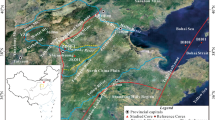Abstract
The Mississippi Fan is a Quarternary accumulation composed of more than seven elongated fan lobes. Isopach and structure maps show frequent shifting of these lobes. The Mississippi Canyon, formed by retrogressive slumping, connects to the youngest fan lobe. The upper fan-lobe is characterized by a large, incised, partially infilled, leveed channel. The middle fan-lobe is aggradational, convex in cross section, with a channel-levee complex on its apex. The lower fan-lobe contains a recently active small channel and several abandoned ones. Depositional patterns can be explained by several processes: “fluvial,” debris flows, and turbidity currents.
Similar content being viewed by others
References
Stuart, C. J., and Caughey, C. A., 1976. Form and composition of the Mississippi Fan. Gulf Coast Association of Geological Societies Transactions, v. 26, pp. 333–343.
Moore, G. T., and others 1978. Mississippi Fan, Gulf of Mexico—physiography, stratigraphy, and sedimentation patterns. In: A. H. Bouma, G. T. Moore, and J. M. Coleman (eds.), Framework, Facies and Oil-Trapping Characteristics of the Upper Continental Margin. American Association of Petroleum Geologists Studies in Geology No. 7, pp. 155–191.
Coleman, J. M., and Bouma, A. H. In press. Mississippi Canyon and deep sea fan: seismic facies and depositional processes. Bulletin of the American Association of Petroleum Geologists.
Garrison, L. E., Kenyon, N. H., and Bouma, A. H., 1982. Channel systems and lobe construction in the Mississippi Fan. Geo-Marine Letters, v. 2, pp. 31–39.
Coleman, J. M., Prior, D. B., and Lindsay, J. F., 1983. Deltaic influences on shelf edge instability processes. In D. J. Stanley and G. T. Moore (eds.), The Shelf Break, Critical Interface on Continental Margins. Society of Economic Paleontologists and Mineralogists Special Publication 33, pp. 121–137.
Bouma, A. H., 1981. Depositional sequences in clastic continental deposits, Gulf of Mexico. Geo-Marine Letters, v. 1, pp. 115–121.
Mutti, E., and Ricci Lucchi, F., 1972. Le torbiditi dell’Appennino settentrionale: introduzione all’analisi di facies. Societa Geologica Italiana Memorie, v. 11, pp. 161–199.
Bouma, A. H., 1973. Leveed-channel deposits, turbidites, and contourites in deeper part of Gulf of Mexico. Gulf Coast Association of Geological Societies Transactions, v. 23, pp. 368–376.
Mutti, E., and Sonnino, M., 1981. Compensation cycles: a diagnostic feature of turbidite sandstone lobes. International Association of Sedimentologists 2nd European Meeting, Bologna, Abstracts, pp. 120–123.
Author information
Authors and Affiliations
Rights and permissions
About this article
Cite this article
Bouma, A.H., Stelting, C.E. & Coleman, J.M. Mississippi Fan: Internal structure and depositional processes. Geo-Marine Letters 3, 147–153 (1983). https://doi.org/10.1007/BF02462460
Received:
Revised:
Issue Date:
DOI: https://doi.org/10.1007/BF02462460




